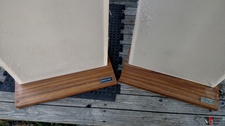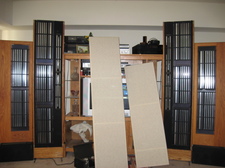It’s the time of year for saving money!
Thus far, in this continuing series on audio reviews and reviewers I’ve asked “Do we really need reviews and reviewers?”, and concluded that we did – if only because we want to make intelligent choices in the toys and goodies we buy for our systems, and there’s so much stuff out there that it’s simply impossible for us to hear even any reasonable part of it for ourselves.
 Next, I pointed-out that any time anybody at all makes any kind of comment about the performance, quality, or value of any piece of hi-fi gear it’s a review – whether it’s in written form or not, and went on to say that the most important thing about any review is, in the end, whether or not we should believe it.
Next, I pointed-out that any time anybody at all makes any kind of comment about the performance, quality, or value of any piece of hi-fi gear it’s a review – whether it’s in written form or not, and went on to say that the most important thing about any review is, in the end, whether or not we should believe it.
I then listed what I think are the three basic requirements for believability and showed that the first one of those — the ability to judge products’ performance – has three requirements of its own: good enough ears; a good enough system; and enough time spent listening to enough stuff of enough kinds to ensure that whatever there is about the system or piece of equipment under review that the reviewer ought to know about has been heard.
Most recently, I’ve been writing about the second of the basic requirements for a believable review — a working standard for judging whether a product under review is good, bad, or indifferent and, in line with that, I described a reviewing standard that had been used by me and Tom Miiller in our days of writing for Sounds Like… Magazine. That was simply, regardless of anything else, whether or not it could make us believe that we were listening to a live performance by live musicians.
In the most recent installment of this continuing series, I added a suggestion from Jack English (another of our Sounds Like… Magazine reviewing colleagues), that one way to judge the believability of a review is to compare your own impressions of a number of products that you have heard for yourself with the stated opinions of the same products by a reviewer and – because we all have differing tastes and preferences — choose to believe reviews of products you DON’T know by how close the reviewer’s opinions are to your own about the products that you DO know.
What, though, if two reviewers you have total confidence in have completely different opinions of two products that you have heard for yourself? Whom (or what) should you believe?
 That actually happened some years ago, with two different pairs of speakers, and the two “reviewers” involved were me and my friend Tony DiChiro, who was, at the time, president of, and chief designer for Kinergetics Research, a highly regarded manufacturer of High-End audio electronics.
That actually happened some years ago, with two different pairs of speakers, and the two “reviewers” involved were me and my friend Tony DiChiro, who was, at the time, president of, and chief designer for Kinergetics Research, a highly regarded manufacturer of High-End audio electronics.
Back around 1990, Tony and I were listening buddies, with similar systems and, except for one small thing, virtually identical listening rooms. Both of our rooms had nearly identical dimension; both were living rooms with (also near identical) connecting dining rooms at their far end; and both had open areas to the left of our normal listening positions. The only real difference was that my living room had a fireplace, with a (roughly) four foot walk-through on either side of it separating the living room from the dining room and Tony’s two rooms were separated by a large central walkway flanked by two narrow (two or three foot wide) divider walls.
My main speakers at that time (that I still love, even today) were a pair of Acoustat 1+1s, which were set up on either side of my fireplace, just ahead of the walk-throughs. Tony and I both liked them, and when Acoustat announced that they were coming out with new and better transformers for their speakers, Tony told me that he was going to buy a pair of 1+1s for himself and I asked him, when he called Acoustat, to order a pair for me, too.
When the new speakers came, I set mine up exactly where my old ones had been and he positioned his at equivalent positions in his room, just in front of the narrow divider walls.
After they had burned-in for a week or so, (always necessary with Acoustats) I was very pleased with my new speakers, and called Tony to see how his were doing, only to learn that his didn’t sound good. Because both pairs of speakers had come from the same batch, and had been ordered and shipped on the very same day, I told him that mine were terrific and suggested that if he just gave his a little more burn-in time, they would probably sound great, too.
He did that, but the next time we spoke, after another week or so had gone by, he said that his speakers still didn’t sound right, and asked me to come to his house to see if I could figure out why. When I got there, it didn’t take much listening at all to hear that he was right: The speakers didn’t sound very good at all. In hopes of learning the reason, we loaded them up and physically hauled them over to my house for a direct comparison with mine and, when we did that, were amazed to find that, as bad as they had sounded at Tony’s house, in my room they were terrific!
I didn’t want Tony to be stuck with speakers that didn’t work for him, so I bought his pair of 1+1s from him right then and there. That’s why I still have three pairs (my original pair, my newly ordered pair, and Tony’s pair) of Acoustats.
 That’s not the end of the story, though: Shortly after I had bought Tony’s Acoustats, Bruce Thigpen announced his Eminent Technology Model 4 speakers, which were “planar magnetics” similar to Magnepans, but with magnets on both sides of the diaphragm, for “push-pull” operation. Tony ordered a pair of these and, when they came, put them in exactly the same spots where, before, he had put his Acoustats, and got sound from them so good that he immediately called me to come out and listen.
That’s not the end of the story, though: Shortly after I had bought Tony’s Acoustats, Bruce Thigpen announced his Eminent Technology Model 4 speakers, which were “planar magnetics” similar to Magnepans, but with magnets on both sides of the diaphragm, for “push-pull” operation. Tony ordered a pair of these and, when they came, put them in exactly the same spots where, before, he had put his Acoustats, and got sound from them so good that he immediately called me to come out and listen.
He was absolutely right: They were wonderful – so good, in fact, that my first thought was to sell my Acoustats and buy a pair of them. Remembering, though, what had happened before, we loaded-up his ET4s and took them to my house for direct comparison with my Acoustats (The same pair, in fact, that I had bought from Tony when they didn’t work at his house). At my house, the ETs sounded just as bad as the Acoustats had sounded at his, and that, FOR THE SECOND TIME, proved to us that even the exact same pair of speakers; even used in closely similar systems; even heard in nearly identical rooms by competent listeners with nearly identical tastes and preferences, can present VASTLY different performance and result in radically different “reviews”.
So what does all that mean? Possibly that even that great suggestion from Jack English, that you pick a reviewer to believe who seems to have the same idea of what “good” means as you do, doesn’t necessarily work, and that even such a simple thing as a seemingly tiny difference between the reviewer’s listening room and yours could invalidate everything that he says.
In the end, it still comes down to just one thing: Your own ears and your own system in your own room are the very best tools you have available to you for decision-making.
Even so, reviews and reviewers are still necessary, and I’ll have more to say about them next time.





